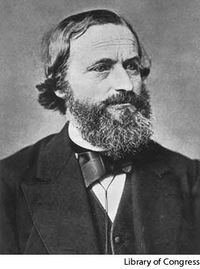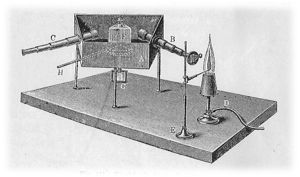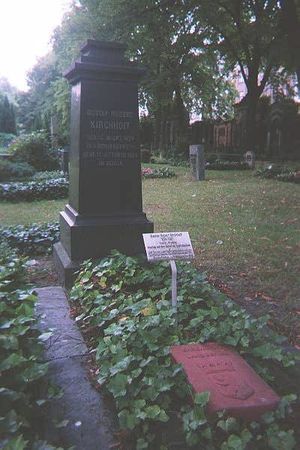گوستاف كيرشوف
گوستاف روبرت كيرشوف Gustav Robert Kirchhoff (و. 12 مارس 1824 - ت. 17 أكتوبر 1887) فيزيائي ألماني كان له دور كبير في فهم عمل الدوائر الكهربية والمنظار الطيفي، وإشعاع الأجسام السوداء للمواد المسخنة. صاغ تعبير "جسم أسود"، كما صاغ مجموعتين من المبادئ المنفصلة في الدوائر الكهربية والإنبعاث الحراري وكلاهما يسمى "قوانين كيرشوف". وبالاشتراك مع روبرت بنسن اكتشفا عنصري سيزيوم وروبيديوم عام 1861 بينما كانا يدرسان التحليل الكيميائي للشمس عبر أثرها الطيفي.
السيرة
ولد كيرشوف في 12 مارس 1824 في مدينة كونيگسبرگ KOnigsberg، پروسيا، ابناً لفريدرش كيرشوف، المحامي، و يوهانا هنرييت ڤيتكه.[3] His family were Lutherans in the Evangelical Church of Prussia.
درس كيرشوف في جامعة كونيگسبرگ، حيث حضر سمينار الرياضيات والفيزياء الذي أداره C. G. J. Jacobi,[4] Franz Ernst Neumann, and Friedrich Julius Richelot. In 1845, while a student, Kirchhoff formulated two circuit laws—which are now ubiquitous in electrical engineering. He completed this study as a seminar exercise; it later became his doctoral thesis, supervised by Neumann. وفي نفس هذا العام 1847 صاغ قانونيه المشهورين في الدارات الكهربائية، ويعرف أحدهما بقانون العُقَد junction rule والآخر بقانون الحَلَقات loop rule. وينصّ القانون الأول على أن المجموع الجبري للتيارات الكهربائية عند أي عقدة في الدارة يساوي الصفر، في حين ينص القانون الثاني على أن المجموع الجبري لفروق الكمون والقوى المحركة في حلقة مغلقة يساوي الصفر.[5]
In 1847, Kirchhoff graduated from the University of Königsberg and became a Privatdozent (unsalaried lecturer) at the University of Berlin, where he stayed until 1850 when he was offered a professorship at the University of Breslau. In 1854, he was called to the University of Heidelberg, where he collaborated with Robert Bunsen in spectroscopic work. In 1875, Kirchhoff returned to Berlin, where he remained until his death in 1887.
In 1857, Kirchhoff married Clara Richelot, the daughter of his mathematics professor Richelot; the couple had five children. In 1872, after Clara's death in 1869, he married Luise Brömmel.[6]
In 1864, Kirchhoff was elected a Member of the American Philosophical Society.[7] In 1884, he became a Foreign Member of the Royal Netherlands Academy of Arts and Sciences.[8]
Kirchhoff died on 17 October 1887 in Berlin at the age of 63. He is buried at Alter St.-Matthäus-Kirchhof (Old St. Matthew's Cemetery) in Schöneberg, Berlin (just a few meters from the graves of the Brothers Grimm).
أبحاث

In 1857, Kirchhoff calculated that an electric signal in a resistanceless wire travels along the wire at the speed of light.[9][10]
In 1859, Kirchhoff proposed a law of thermal radiation, and gave a proof in 1861.
Together, Kirchhoff and Bunsen improved on Joseph von Fraunhofer's 1814 spectroscope, which Kirchhoff used to pioneer the identification of the elements in the Sun, showing in 1859 that the Sun contains sodium. Kirchhoff and Bunsen discovered caesium and rubidium in 1861.[11]
Kirchhoff contributed greatly to the field of spectroscopy by formalizing three laws that describe the spectral composition of light emitted by incandescent objects, building substantially on the discoveries of David Alter and Anders Jonas Ångström. In 1862, he was awarded the Rumford Medal "for his researches on the fixed lines of the solar spectrum, and on the inversion of the bright lines in the spectra of artificial light".[أ]
Kirchhoff also contributed to optics, carefully solving the wave equation to provide a solid foundation for Huygens' principle (and correct it in the process).[13][14]
Kirchhoff's circuit laws
Kirchhoff's first law At any node in an electrical circuit where current can branch, the sum of the currents leaving the node is equal to the sum of the currents entering the node. The second law is that the algebraic sum of the potential drops along a closed circuit, taken in any direction of flow, is equal to zero.[15]
قوانين كيرشوف الثلاث للمطيافية
- A solid, liquid, or dense gas excited to emit light will radiate at all wavelengths and thus produce a continuous spectrum.
- A low-density gas excited to emit light will do so at specific wavelengths, and this produces an emission spectrum.
- If light composing a continuous spectrum passes through a cool, low-density gas, the result will be an absorption spectrum.
Kirchhoff did not know about the existence of energy levels in atoms. The existence of discrete spectral lines had been known since Fraunhofer discovered them in 1814. That the lines formed a discrete mathematical pattern was described by Johann Balmer in 1885. Joseph Larmor explained the splitting of the spectral lines in a magnetic field known as the Zeeman Effect by the oscillation of electrons.[16][17] These discrete spectral lines were not explained as electron transitions until the Bohr model of the atom in 1913, which helped lead to quantum mechanics.
Kirchhoff's law of thermal radiation
It was Kirchhoff's law of thermal radiation in which he proposed an unknown universal law for radiation that led Max Planck to the discovery of the quantum of action leading to quantum mechanics.
قانون الكيمياء الحرارية
Kirchhoff showed in 1858 that, in thermochemistry, the variation of the heat of a chemical reaction is given by the difference in heat capacity between products and reactants:
- .
Integration of this equation permits the evaluation of the heat of reaction at one temperature from measurements at another temperature.[18][19]
Kirchhoff's theorem in graph theory
Kirchhoff also worked in the mathematical field of graph theory, in which he proved Kirchhoff's matrix tree theorem.
أعمال
- Gesammelte Abhandlungen (in الألمانية). Leipzig: Johann Ambrosius Barth. 1882.
- Vorlesungen über Electricität und Magnetismus (in الألمانية). Leipzig: Benedictus Gotthelf Teubner. 1891.
- Vorlesungen über mathematische Physik. 4 vols., B. G. Teubner, Leipzig 1876–1894.
- Vol. 1: Mechanik. 1. Auflage, B. G. Teubner, Leipzig 1876 (online).
- Vol. 2: Mathematische Optik. B. G. Teubner, Leipzig 1891 (Herausgegeben von Kurt Hensel, online).
- Vol. 3: Electricität und Magnetismus. B. G. Teubner, Leipzig 1891 (Herausgegeben von Max Planck, online).
- Vol. 4: Theorie der Wärme. B. G. Teubner, Leipzig 1894, Herausgegeben von Max Planck[20]
انظر أيضاً
- Kirchhoff's circuit laws
- معادلات كيرشوف
- Kirchhoff–Love plate theory
- Piola–Kirchhoff stress tensor
- Kirchhoff's law of thermal radiation
- Kirchhoff's three laws of spectroscopy
- معهد كيرشوف للفيزياء
- Spectroscope
- مبرهنة كيرشوف
- صيغة كيرشوف للتشتت
الهوامش والمصادر
- ^ أ ب ت ث ج ح خ د ذ ر "Gustav Kirchhoff - The Mathematics Genealogy Project". genealogy.math.ndsu.nodak.edu. Retrieved 2025-10-15.
- ^ أ ب ت ث ج ح خ د ذ ر "Gustav Robert Kirchhoff - Physics Tree". academictree.org. Retrieved 2025-10-15.
- ^ Kondepudi, Dilip; Prigogine, Ilya (5 November 2014). Modern Thermodynamics: From Heat Engines to Dissipative Structures (in الإنجليزية). John Wiley & Sons. p. 288. ISBN 9781118698709.
- ^ Hockey, Thomas (2009). "Kirchhoff, Gustav Robert". The Biographical Encyclopedia of Astronomers. Springer Nature. ISBN 978-0-387-31022-0. Retrieved 22 August 2012.
- ^ "كيرتشوف (غوستاف روبير ـ)(1824ـ 1887)". الموسوعة العربية.
- ^ "Gustav Robert Kirchhoff – Dauerausstellung". Kirchhoff-Institute for Physics. Retrieved 18 March 2016.
Am 16. August 1857 heiratete er Clara Richelot, die Tochter des Königsberger Mathematikers ... Frau Clara starb schon 1869. Im Dezember 1872 heiratete Kirchhoff Luise Brömmel.
- ^ "APS Member History". search.amphilsoc.org. Retrieved 2021-04-16.
- ^ "G. R. Kirchhoff (1824–1887)". Royal Netherlands Academy of Arts and Sciences. Retrieved 22 July 2015.
- ^ Kirchhoff, Gustav (1857). "On the motion of electricity in wires". Philosophical Magazine. 13: 393–412.
- ^ Graneau, Peter; Assis, André Koch Torres (1994). "Kirchhoff on the motion of electricity in conductors" (PDF). Apeiron. 1 (19): 19–25. Archived (PDF) from the original on 2006-01-08.
- ^ Weeks, Mary Elvira (1956). The discovery of the elements (6th ed.). Easton, PA: Journal of Chemical Education.
- ^ Asimov, Isaac, The Secret of the Universe, Oxford University Press, 1992, p. 109
- ^ Baker, Bevan B.; and Copson, Edward T.; The Mathematical Theory of Huygens' Principle, Oxford University Press, 1939, pp. 36–38.
- ^ Miller, David A. B.; "Huygens's wave propagation principle corrected", Optics Letters 16, 1370–1372, 1991
- ^ Corso di Fisicia 2 author Paul A .Tipler
- ^ Buchwald, Jed Z.; and Warwick, Andrew; editors; Histories of the Electron: The Birth of Microphysics
- ^ Larmor, Joseph (1897), "On a Dynamical Theory of the Electric and Luminiferous Medium, Part 3, Relations with material media", Philosophical Transactions of the Royal Society 190: 205–300, doi:, Bibcode: 1897RSPTA.190..205L
- ^ Laidler, Keith J.; and Meiser, J. H.; "Physical Chemistry", Benjamin/Cummings 1982, p. 62
- ^ Atkins, Peter; and de Paula, J.; "Atkins' Physical Chemistry", W. H. Freeman, 2006 (8th edition), p. 56
- ^ Merritt, Ernest (1895). "Review of Vorlesungen über mathematische Physik. Vol. IV. Theorie der Wärme by Gustav Kirchhoff, edited by Max Planck". Physical Review. American Physical Society: 73–75.
- Warburg, E. (1925). "Zur Erinnerung an Gustav Kirchhoff". Die Naturwissenschaften. 13 (11): 205. Bibcode:1925NW.....13..205W. doi:10.1007/BF01558883.
- Stepanov, B. I. (1977). "Gustav Robert Kirchhoff (on the ninetieth anniversary of his death)". Journal of Applied Spectroscopy. 27 (3): 1099. Bibcode:1977JApSp..27.1099S. doi:10.1007/BF00625887.
- Everest, A S (1969). "Kirchhoff-Gustav Robert 1824–1887". Physics Education. 4 (6): 341. Bibcode:1969PhyEd...4..341E. doi:10.1088/0031-9120/4/6/304.
- Kirchhoff, Gustav (1860). "Ueber die Fraunhoferschen Linien". Monatsberichte, Akademie der Wissenschaften, Berlin: 662–665. ISBN 978-1-113-39933-5.
قراءات خارجية
- گوستاف كيرشوف at the Mathematics Genealogy Project
- O'Connor, John J.; Robertson, Edmund F., "گوستاف كيرشوف", MacTutor History of Mathematics archive
- Weisstein, Eric W., Kirchhoff, Gustav (1824–1887) at ScienceWorld.
- Kirchhoff's 1857 paper on the speed of electrical signals in a wire
 Texts on Wikisource:
Texts on Wikisource:
- "Kirchhoff, Gustav Robert". Encyclopedia Americana. 1920.
- Beach, Chandler B., ed. (1914). The New Student's Reference Work. Chicago: F. E. Compton and Co.
{{cite encyclopedia}}: Missing or empty|title=(help) - Chisholm, Hugh, ed. (1911). . دائرة المعارف البريطانية (eleventh ed.). Cambridge University Press.
{{cite encyclopedia}}: Cite has empty unknown parameter:|coauthors=(help) - "Kirchhoff, Gustav Robert". New International Encyclopedia. 1905.
- قالب:Cite PSM
- Ripley, George; Dana, Charles A., eds. (1879). The American Cyclopædia.
{{cite encyclopedia}}: Missing or empty|title=(help)
خطأ استشهاد: وسوم <ref> موجودة لمجموعة اسمها "lower-alpha"، ولكن لم يتم العثور على وسم <references group="lower-alpha"/>
- Short description is different from Wikidata
- Pages using infobox scientist with unknown parameters
- Articles with hatnote templates targeting a nonexistent page
- CS1 الألمانية-language sources (de)
- CS1 errors: missing title
- Wikipedia articles incorporating citation to the NSRW
- Wikipedia articles incorporating citation to the NSRW with no title or wstitle parameter
- Wikipedia articles incorporating citation to the NSRW with an unnamed parameter
- مقالات المعرفة المحتوية على معلومات من دائرة المعارف البريطانية طبعة 1911
- Wikipedia articles incorporating a citation from The American Cyclopaedia
- Wikipedia articles incorporating a citation from The American Cyclopaedia with an unnamed parameter
- مواليد 1824
- وفيات 1887
- ألمان
- فيزيائيون ألمان
- مكتشفو عناصر كيميائية
- أشخاص من كاليننگراد
- فيزيائيو البصريات
- أشخاص من شرق پروسيا
- أشخاص من كونيگسبرگ
- خريجو جامعة كونيگزبرگ
- طاقم تدريس جامعة برسلاو
- طاقم تدريس جامعة هايدلبرگ
- طاقم تدريس جامعة هومبولت في برلين
- زملاء فخريون بالجمعية الملكيه ادنبره
- أعضاء أجانب في الجمعية الملكية
- Foreign associates of the National Academy of Sciences
- Members of the Royal Netherlands Academy of Arts and Sciences
- Recipients of the Pour le Mérite (civil class)
- Physicists from the Kingdom of Prussia
- 19th-century German physicists
- Rare earth scientists
- Fellows of the Royal Society of Edinburgh
- Recipients of the Matteucci Medal
- Members of the Göttingen Academy of Sciences and Humanities
- Recipients of the Cothenius Medal
- International members of the American Philosophical Society





